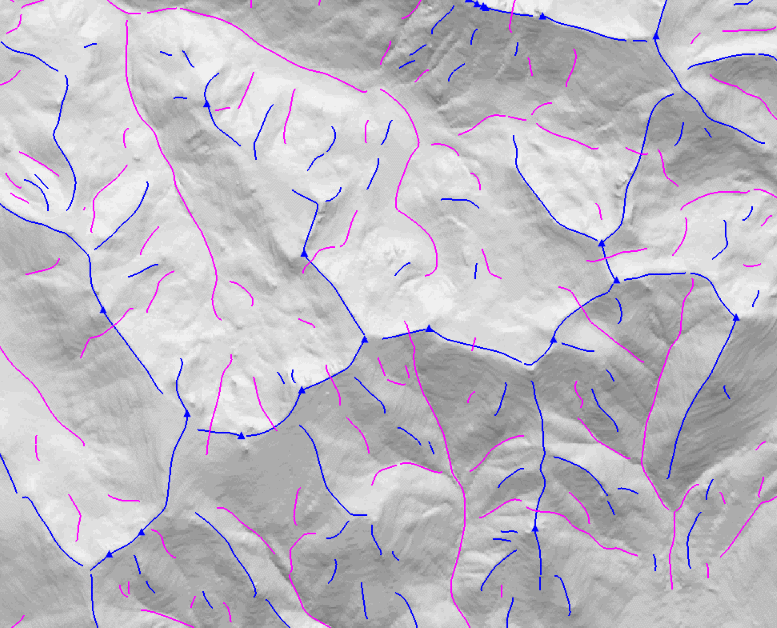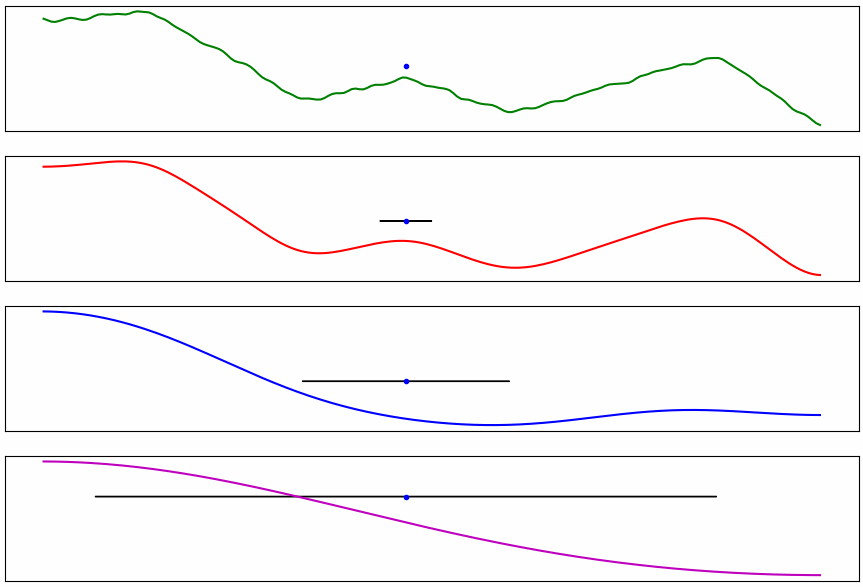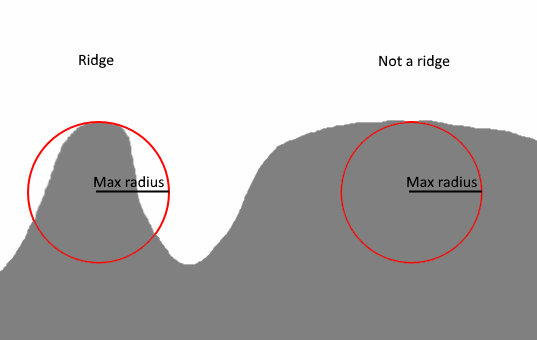RidgeOperator Class
Generates lines representing ridges and valleys and points representing peaks and basins.
NuGet/Assembly: Carmenta.Engine.5.17.0.nupkg (in the CEOperators assembly)
Syntax
public class RidgeOperator : UnaryOperatorRemarks
There is a map configuration sample ridge_operator.px that shows you how to detect ridges, valleys, peaks and basins from elevation data.
The RidgeOperator can be used to detect terrain features such as ridges, valleys, peaks and basins.
 |
The operator is designed to accept numeric (integer or float valued) elevation raster geometries as input. The operator will throw an exception if any other kind of geometry is provided.
Detection
Ridges and valleys
Each point on a surface has in addition to an elevation and slope (the rate of elevation change) also curvature (the rate of slope change).
Because a surface is two dimensional, there are at each point two orthogonal curvature directions representing the maximum and minimum curvatures in that point. A ridge is defined as the points on a surface where the surface gradient (slope) is orthogonal to the direction of most negative curvature. Likewise, a valley is defined as the points where the gradient is orthogonal to the direction of the most positive curvature.
Peaks and basins
Peaks and basins are simple local minimums and maximums respectively. Any point that is strictly larger than any of its neighbors is detected as a peak and any point strictly smaller than its neighbors is detected as a basin.
Parameters
Characteristic size
What constitutes a detectable terrain feature is dependent on the characteristic size property. A large characteristic size means that only large objects such as mountain ranges are detected while a smaller size results in the detection of smaller bumps and crevices. The CharacteristicSize property is used to smooth the analyzed terrain data. The effect of different CharacteristicSize values are illustrated in the image below. Notice that the whether a point is determined to be located on a ridge, in a valley or on a slope is dependent on the CharacteristicSize property.
 |
The smoothed height data is used to detect both line and point geometries.
Thanks to the CharacteristicSize property, the operator behavior is mostly independent of the current View.Scale. However, when the View is zoomed out, the elevation dataset will typically switch to coarser overview rasters, and when the RidgeOperator gets a coarse enough raster, a small value of CharacteristicSize will cease to have an effect.
Curvature threshold
There is also a threshold that excludes ridges and valleys that are insufficiently pronounced. This threshold is applied like a circle touching the surface along the ridge's curvature axis. if the surface bends inside the surface, the ridge is detected, otherwise not. This threshold is set using the maximum curvature radius parameter. The unit of this parameter is meters. The MaxCurvatureRadius does not affect detection of point-geometries.
 |
Minimum length
Finally, there is a property MinLength that is used to filter out ridges and valleys that are too short.
Output
RidgeOperator has two properties controlling its output: OutputLines and OutputPoints. When OutputLines is set to true, the operator generates line features indicating the location of ridges and valleys. These line features will be decorated with true-valued boolean attributes isRidge and isValley, respectively. When OutputPoints is set to true, the operator will generate point-geometries for peaks and basins with the true-valued attributes isPeak and isBasin, respectively.
Inheritance Hierarchy
System.Object
EngineObject
Operator
UnaryOperator
RidgeOperator
Platforms
Windows, Linux, Android
RidgeOperator Members
The RidgeOperator type has the following members.
Constructors
| Name | Description |
|---|---|
| RidgeOperator | Initializes a new instance of the RidgeOperator class. |
Properties
| Name | Description |
|---|---|
| CharacteristicSize | Gets or sets the characteristic size of this operator, in meters. |
| Description | Gets or sets a short description of the operator. Inherited from Operator |
| DisplayName | Gets or sets a display name for the operator. Inherited from Operator |
| Input | Gets or sets the input operator, from which this operator reads features. Inherited from UnaryOperator |
| IsDisposed | Gets a value that tells whether the current RidgeOperator has been disposed. Inherited from EngineObject |
| IsoMetadataDocument | Gets or sets the path to an ISO 19139 metadata document for the operator. Inherited from Operator |
| MaxCurvatureRadius | Gets or sets a value in meters specifying the maximum curvature radius allowed for generated features. |
| MinLength | Gets or sets the minimum length in meters of detected line geometries. |
| Name | Gets or sets the name of the operator. Inherited from Operator |
| NativeHandle | Gets the native Carmenta Engine kernel object the current RidgeOperator represents. Inherited from EngineObject |
| OutputLines | Gets or sets whether line geometries for ridges and valleys are generated by the operator. |
| OutputPoints | Gets or sets whether point geometries for peaks and basins are generated by the operator. |
| IUserProperties.UserProperties | Gets the AttributeSet that contains the user properties. Inherited from IUserProperties |
Methods
| Name | Description |
|---|---|
| Clone | Creates a copy of an object. Inherited from EngineObject |
| Dispose | Releases the reference to the native Carmenta Engine kernel instance the EngineObject represents. Inherited from EngineObject |
| Equals | Determines whether this instance is equal to another. Inherited from EngineObject |
| FindChildObject | Overloaded. Finds the child object with the specified name. Inherited from Operator |
| FlushCache | Removes the objects that have been cached by the operator. Inherited from Operator |
| GetChildObjects | Overloaded. Gets the child objects of the current object. Inherited from Operator |
| GetFeatures | Overloaded. Gets features from the operator chain. Inherited from Operator |
| GetLocalizedDescription | Gets a localized version of the operator description in a specific language. Inherited from Operator |
| GetLocalizedDisplayName | Gets a localized version of the operator display name in a specific language. Inherited from Operator |
| GetLocalizedIsoMetadataDocument | Gets the path to an ISO 19139 metadata document for a specific language. Inherited from Operator |
| GetRasterFeature | Overloaded. Gets raster features from the operator chain and merges them into a single raster. Inherited from Operator |
| HasLocalizedDescription | Checks if a localized version of the operator description is available in a specific language. Inherited from Operator |
| HasLocalizedDisplayName | Checks if a localized version of the operator display name is available in a specific language. Inherited from Operator |
| HasLocalizedIsoMetadataDocument | Checks if an ISO 19139 metadata document is available for a specific language. Inherited from Operator |
| SetLocalizedDescription | Sets a operator description in a specific language. Inherited from Operator |
| SetLocalizedDisplayName | Sets a operator display name in a specific language. Inherited from Operator |
| SetLocalizedIsoMetadataDocument | Sets the path to an ISO 19139 metadata document for the operator, for a specific language. Inherited from Operator |